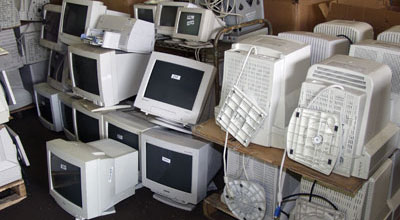In this world of rapidly changing technology, disposal of electronic waste (e-waste) has created a growing waste stream. The Division of Waste and Hazardous Substances provides guidance for the management of these wastes by businesses under the state’s hazardous waste regulations.
E-waste are electronics that usually incorporate a printed circuit board in their assembly are destined for storage, disposal or recycling. Examples of e-waste include, but are not limited to:
E-waste is typically generated when an electronic product becomes defective, requires major repairs, or ceases to deliver economical results. This fundamental concept is often referred to as “end of useful life (EOL).”

The following is a brief outline of proper management and disposal questions commonly asked regarding the disposal of e-waste.
Please remember this information is intended to serve as a guide and does not supersede Delaware’s Regulations Governing Hazardous Waste (7 DE Admin. Code 1302).
When possible, e-waste generators should ship their intact e-waste off-site to an electronics recycler or send the waste to a revers logistics center.
If a site chooses to dispose of their e-waste in lieu of recycling or shipping to a reverse logistics center, then the generator must make an accurate determination, as explained in §262.11.
Note: Disposal of any hazardous waste into Delaware’s solid waste landfills by hazardous waste generators, including by Very Small Quantity Generators, is prohibited.
How to Become a CRT Collector or Processor
Collectors or processors of CRT glass are subject to the requirements of Part 261, Subpart E of the hazardous waste regulations. For additional information, please contact the Compliance and Permitting Section.
Older computers and televisions use a Cathode Ray Tube (CRT) for viewing. The CRT contains lead to shield users from the radioactivity required to produce the image. Improper disposal of CRTs can place lead in the municipal solid waste stream that represents an environmental and health hazard.
A conditional exclusion from the definition of hazardous waste (CRTs remain a solid waste) is available for generators of used intact CRTs, and used broken CRTs. The conditional exclusion under §261.4(b)(16) only applies to CRTs that are not disposed and meet the following conditions:
Used intact CRTs
Store in a structurally sound, fully enclosed building (i.e., roofed, walled and with an impervious floor) or place into a well-constructed container that remains in good condition and is kept closed. When storing used intact CRTs in containers, label the containers “Used Cathode Ray Tube(s) – Contains Leaded Glass,” and keep the container(s) in a structurally sound roofed structure constructed on an underlying impervious base.
Ensure CRTs are not stored on site for more than one year.
Demonstrate the date that each CRT was first taken out of service.
Used Broken CRTs
Store the CRTs and all associated glass in well-constructed containers that remain in good condition.
Maintain containers in a structurally sound roofed structure constructed on an underlying impervious base.
Label the containers “Used Cathode Ray Tube(s) – Contains Leaded Glass” or “Leaded Glass from Televisions or Computers.” The containers must also be labeled “Do Not Mix With Other Glass Materials.”
Ensure the CRTs are not stored on site for more than one year.
Demonstrate the date that each CRT was first taken out of service. For used broken CRTs, the out of service date is when the CRT was first removed from service, not from when the CRT glass became broken, if that occurred at a later date.
If any of the conditions for exclusion are not met, the generator must manage used intact CRTs and used broken CRTs as hazardous waste.
Heavy metals are commonly used in electronic components such as printed circuit boards. As there are many types of circuit boards, it is difficult to use knowledge to categorize them as either hazardous or non-hazardous waste. Circuit boards may also contain batteries and mercury switches, both components that routinely are hazardous waste.
Printed circuit boards destined for recycling are covered by the scrap metal exemption (§261.6(a)(3)(ii)). This exemption allows used, whole circuit boards being recycled to be shipped without becoming subject to full hazardous waste regulation.
Shredded circuit boards destined for recycling are excluded from the definition of solid waste, therefore are not hazardous waste (§261.4(a)(14)), provided the circuit boards are stored in containers sufficient to prevent a release to the environment prior to recovery, and are free of mercury switches, mercury relays, nickel‑cadmium batteries and lithium batteries.
Once removed, batteries and mercury switches must be managed as hazardous waste or managed under the less stringent Universal Waste Rule in Part 273 of the regulations. Be aware that many of the mercury switches, mercury relays, nickel-cadmium batteries and lithium batteries used in the manufacture of circuit boards may be very small and may, on occasion, escape visual inspection. Therefore, directing the entire electronic component to an electronics recycler, rather than first attempting disassembly, is recommended. For assistance with locating an electronics recycler, please visit sustainableelectronics.org/recyclers or contact the Compliance and Permitting Section.
While recycling is the preferred method for managing circuit board waste, the option remains to demonstrate through Toxicity Characteristic Leaching Procedure (TCLP) analysis that circuit boards are non-hazardous waste. When so demonstrated, non-hazardous circuit boards may be disposed in a permitted solid waste landfill. The Delaware Solid Waste Authority (DSWA) operates the state’s solid waste landfills. To dispose of non-hazardous circuit boards in a DSWA landfill, the DSWA must first grant written approval. The DSWA can be contacted at 302-739-5361.
Related Topics: computer, e-waste, electronic, hazardous, Health and Safety, permitting and regulation, waste, waste and hazardous substances, waste management